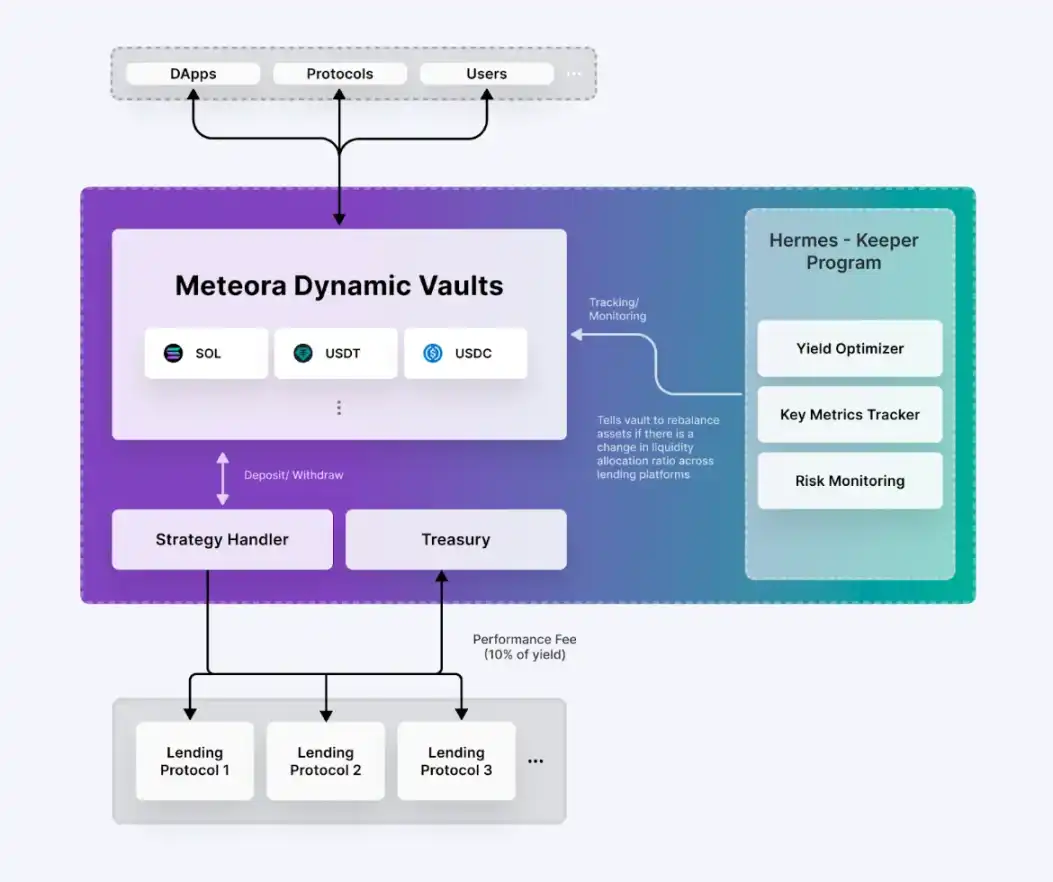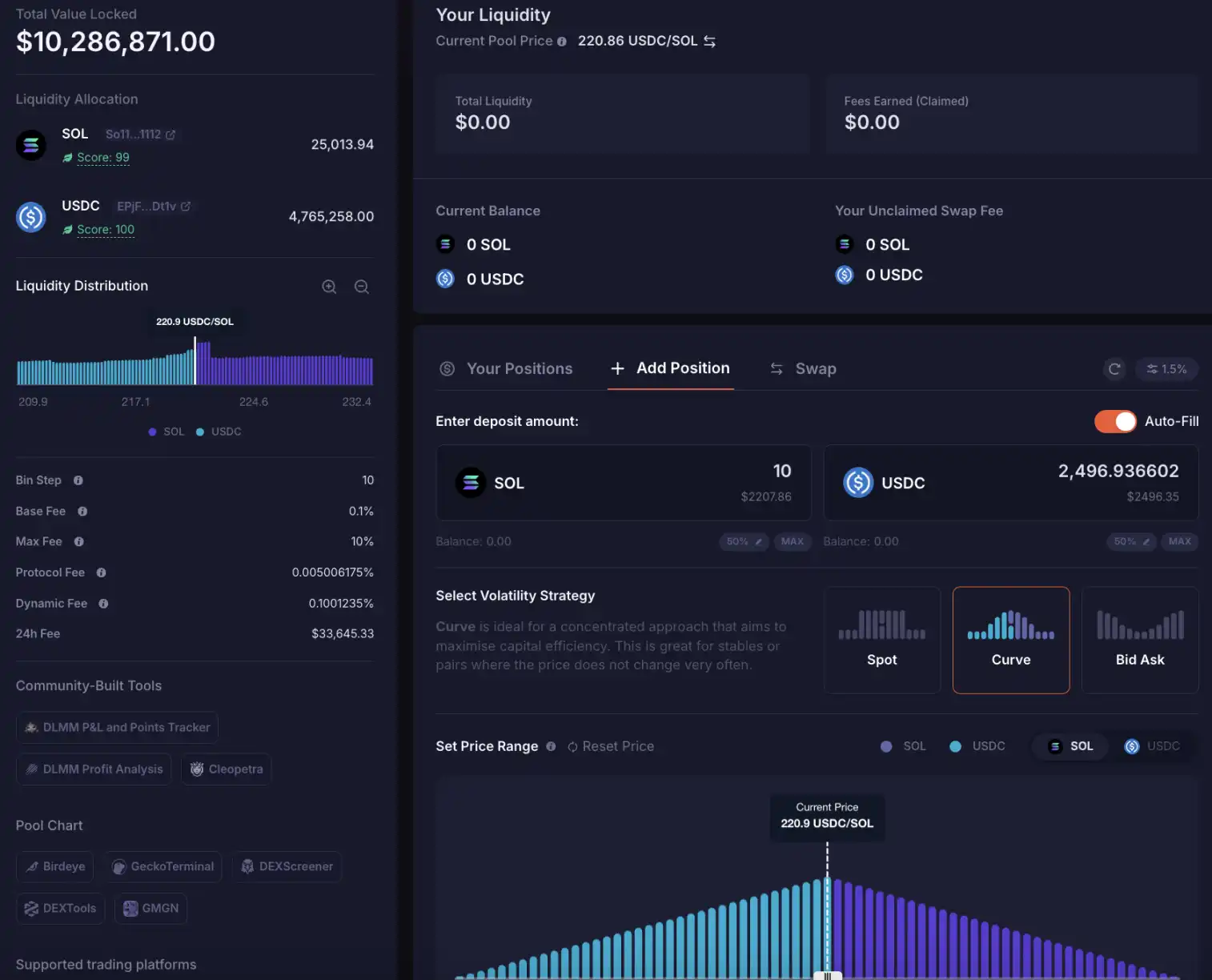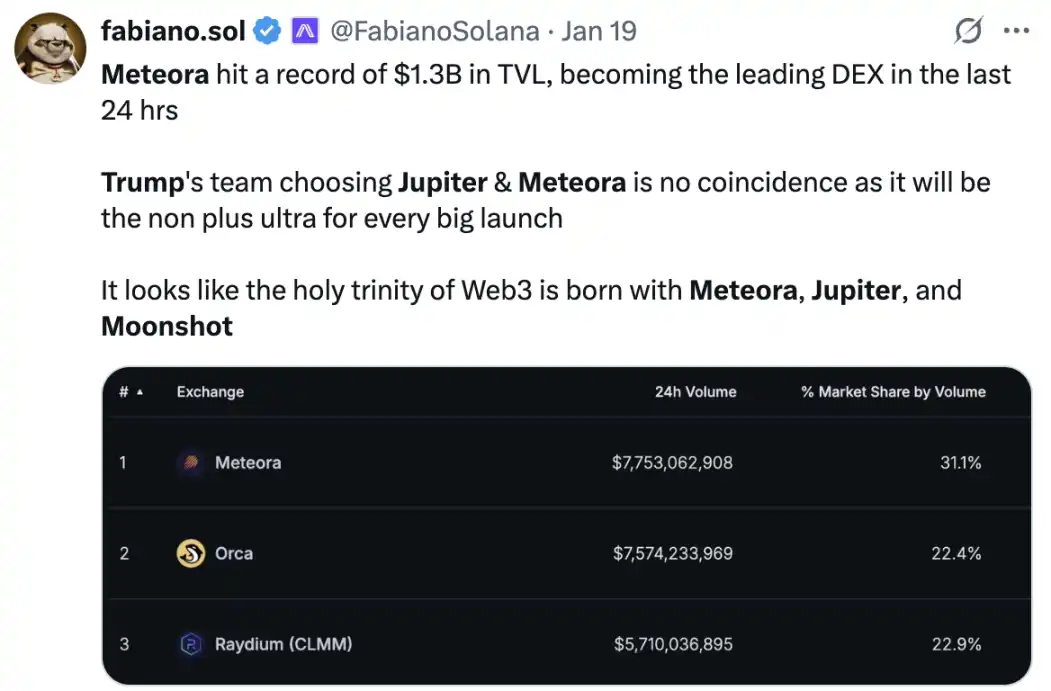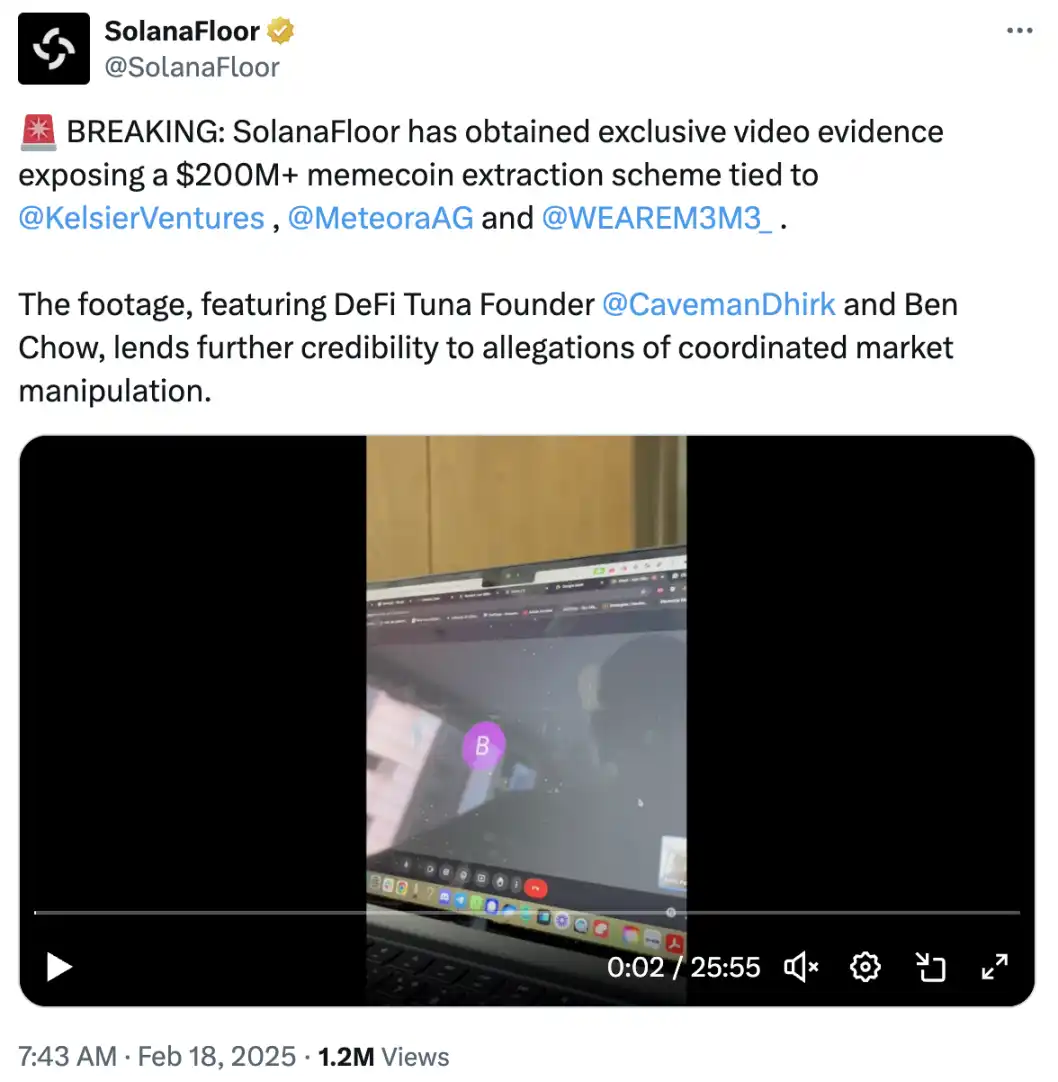Once embroiled in a market manipulation scandal, can Meteora achieve a revival with the help of TGE?
Original Title: "Co-founder Accused of Market Manipulation, Solana's Most Controversial DEX Set to Launch"
Original Author: Eric, Foresight News
Solana DEX Meteora, which plans to officially launch its token MET on the 23rd of this month, announced its tokenomics during the National Day holiday and named the plan "Phoenix Nirvana."
According to the MET tokenomics, 20% is allocated to Mercurial stakeholders; 15% is distributed to Meteora users through the LP incentive program; 2% is allocated to off-chain contributors, i.e., those who have contributed to Meteora's development; 3% is allocated to the Launchpad and Launchpool ecosystem; 3% is allocated to the Jupiter staking incentive program; 3% is allocated to centralized exchanges, market makers, etc.; and 2% is allocated to M3M3 stakeholders. In addition, 18% of MET will be allocated to the team, and 34% will be reserved for Meteora, both linearly unlocked over six years.
In total, 48% of the tokens will be distributed and directly unlocked at TGE, but MET will not be distributed in the usual airdrop format. Instead, 10% of the tokens will be distributed to users in the form of liquidity positions. According to Meteora, this mechanism allows the project team to avoid providing additional tokens for initial liquidity, while users can also earn fee income.
What many people don't know is that Meteora's development journey has been full of ups and downs, and calling it a "Phoenix Nirvana" is not an exaggeration. To understand the story and what Mercurial and M3M3 are in the token distribution plan, we need to start from the beginning.
From "Princeling" to "Prisoner"
Meteora's predecessor, Mercurial Finance, was founded in 2021 as a stablecoin asset management protocol in the Solana ecosystem. Notably, the founding team of Mercurial also developed another protocol, Jupiter, which is now the absolute leader in the Solana DEX sector. One of their co-founders, Ben Zhow, comes from a product design background, having worked at design consulting firms IDEO and AKQA on user experience and product development, and later co-founded social apps Friended and WishWell. Another anonymous co-founder, known as meow, has served as an advisor for multiple DeFi/wallet projects such as Instadapp, Fluid, Kyber, and Blockfolio, and was also an early contributor to the decentralized domain protocol Handshake.
The core of Mercurial is to build a platform focused on providing low slippage for on-chain stablecoin trading and high returns for liquidity providers (LPs). To reduce slippage, Mercurial does not require LPs to provide liquidity in a strict 1:1 token pair ratio. Flexible configuration allows LPs to arbitrage by adding single-sided liquidity after large trades, thereby reducing subsequent trading slippage. In addition, Mercurial uses special price curves to concentrate liquidity within the required range. If a user's trade exceeds the trading rate range, they will receive less liquidity support.
To increase returns, Mercurial adopts a dynamic fee mechanism. Simply put, when trading is active, Mercurial increases trading fees to reduce LPs' impermanent loss; when trading is sluggish, it lowers fees to stimulate trading. On the other hand, after DAO approval, Mercurial can deploy pool assets to external protocols, such as lending, to further increase LP returns.
In the DeFi boom of 2021, protocols like Mercurial, aiming to become the Curve of Solana, were highly sought after. Early on, it received investments from Alameda Research, Solana Ecosystem Fund, OKEx (now OKX), and Huobi, and also conducted an IEO on FTX. At the time, FTX founder Sam Bankman-Fried personally endorsed the project: "The team's strong technical, research, and operational capabilities demonstrate Solana's appeal. We look forward to working with them to enhance Solana's liquidity and usability."
At its peak in early August 2021, Mercurial's TVL accounted for nearly 10% of Solana's total TVL. Even at the end of 2021, when Solana's TVL was close to 10 billions USD, Mercurial's TVL still accounted for more than 2%. While it may not have been the backbone, it was still one of the important DeFi infrastructures on Solana.
The rest of the story is well known: the Solana ecosystem cooled off completely in the 2022 bear market and hit rock bottom with the FTX collapse. Mercurial, closely tied to FTX, was severely damaged, with its TVL plummeting and remaining sluggish. By October 2023, its TVL had dropped below 10 millions USD, less than 5% of its peak. Similar stories have happened to many DeFi projects that have since faded away, but Mercurial's story did not end there.
Pivoting to Focus on DEX, Gaining Fame with TRUMP
On December 27, 2022, Mercurial published an article on Medium announcing the Meteora plan, including launching Dynamic Vaults and AMM on the Meteora platform, introducing a new token to replace the original MER, completing a brand overhaul, and transitioning to Meteora.org.
At that time, Mercurial focused on Dynamic Vaults, aiming to make Meteora the yield layer on Solana. In the team's vision, Meteora is a new platform composed of Dynamic Vaults, AMM pools, and guardians. Guardians are responsible for monitoring and rebalancing vault assets across different lending protocols every few minutes to provide LPs with the highest returns.

In February 2023, the new platform Meteora officially launched, but as mentioned earlier, the TVL hit its lowest point in October of the same year. Meteora did not escape its slump just by "changing its name." After muddling through for 10 months, a turning point appeared at the end of 2023.
In early December of that year, Meteora announced that it would launch a liquidity incentive program starting January 1, 2024, allocating 10% of the new tokens to users providing liquidity. The incentives covered not only stablecoin liquidity pools but also began to include non-stablecoin asset pools. It was at this moment that Meteora shifted its strategic focus to DEX, and its TVL rose from less than 20 millions USD before December to over 50 millions USD.
Alongside the incentive program, a new AMM model, DLMM (Dynamic Liquidity Market Maker), inspired by Trader Joe, was also launched. Simply put, in the new AMM model, liquidity is not continuous but divided into individual "Bins." Each Bin represents a fixed price, and as long as liquidity in that Bin remains, trading that asset on Meteora occurs at a fixed price with zero slippage.

For example, suppose the current price of SOL is 200 USD and there are two SOL/USDC liquidity Bins on Meteora, priced at 200 USDC and 201 USDC, respectively. If at some point the market price of SOL rises from 200 USD to 201 USD, but there are still 10 SOL left in the 200 USDC Bin on Meteora, then buying up to 10 SOL through Meteora will still execute at 200 USDC. Only when the total purchase exceeds 10 SOL will liquidity move to the 201 USDC Bin.
For users, there are three ways to add liquidity: Spot, Curve, and Bid Ask. Both Spot and Curve distribute liquidity "evenly," but the former is linear averaging, while the latter is curve averaging. The Bid Ask mode allows for single-sided liquidity, such as adding only SOL or USDC to the SOL/USDC pool.

Although Meteora launched new mechanisms, it did not abandon its original AMM+ yield aggregator product, instead naming it DAMM v1 and retaining it in the protocol. The vault, which once had only a few millions USD in TVL during its low point, now has over 90 millions USD at the time of writing. Meteora later launched DAMM v2, independent of v1, featuring highly customizable mechanisms that provide various tools for projects launching new tokens, such as native liquidity mining and single-sided liquidity, to facilitate early value discovery. With its diverse liquidity options, Meteora has become the choice for many new projects to establish initial liquidity. The Launchpad and Launchpool ecosystem, which receives 3% of the tokens, refers to this business segment.
This combination of strategies, while not a dramatic turnaround, stabilized Meteora's position. Meteora began to carve out its own territory in the Solana DEX competition. Although TVL fluctuated between 200 and 300 millions USD, trading volume and its share of total DEX trading volume on Solana gradually increased. In January 2025, a year after the pivot, the emergence of the TRUMP token pushed Meteora's development forward significantly.
At that time, the TRUMP team chose Jupiter, Meteora, and Moonshot as partners. On the evening of January 17 and the morning of the 18th, the TRUMP token issuance team established TRUMP's initial liquidity on Meteora, sparking several days of frenzy. According to DefiLlama data, on the 18th, Meteora's single-day trading volume reached 7.6 billions USD, while the total DEX trading volume on Solana that day was 37.945 billions USD, with Meteora accounting for 20% of the total thanks to TRUMP. By the 20th, Meteora's TVL reached 1.688 billions USD, accounting for 14.7% of Solana's TVL that day, up from less than 470 millions USD just three days earlier.

This event made Meteora famous overnight. As two projects with the same founding team, Jupiter continued to dominate as Solana's aggregator and widened its moat, while Meteora gained the ability to compete with Raydium and Orca, and, thanks to the tens of millions of dollars in fees earned from TRUMP, both Meteora and Jupiter achieved both fame and fortune.
Market Manipulation Scandal Breaks, Co-founder Resigns
The financial effect brought by TRUMP inexplicably sparked a "celebrity meme token craze," including tokens issued in the name of Trump's wife (MELANIA) and LIBRA, promoted by Argentina's President Milei on Twitter. However, unlike TRUMP's wealth effect, these tokens all plummeted after brief surges, causing heavy losses for many investors. Especially after the LIBRA debacle, Milei strongly denied that LIBRA was issued by him, saying he merely retweeted related information. This brought LIBRA's real creator, Hayden Davis, and his company Kelsier Ventures, where he serves as CEO, into the spotlight.
DefiTuna founder Moty subsequently revealed that Meteora and Kelsier Ventures were the masterminds behind all this, and the tokens involved went far beyond MELANIA and LIBRA. Kelsier profited by manipulating the prices of meme tokens launched via the meme token Launchpad M3M3 (which Meteora claims is a community-launched platform), including MELANIA and LIBRA, with total profits reaching as high as 200 millions USD.
Meteora co-founder Ben was the first to clarify his relationship with Kelsier Ventures, stating that when M3M3 was launched, he merely asked Kelsier if they were willing to issue tokens on the platform to help with testing. Ben said that in this cooperation, Kelsier Ventures "seemed trustworthy," so he recommended them to the MELANIA team. In the launches of MELANIA and LIBRA, Meteora and Ben only provided technical support and did not manipulate prices.

However, the day after Ben's clarification, Moty released a video that essentially "confirmed" that Meteora and Kelsier Ventures colluded to manipulate the prices of a large number of meme tokens, forcing Ben to resign under pressure. Meteora's other co-founder, meow, also posted on X, expressing belief that the Meteora team and Ben did not engage in insider trading or market manipulation, and stated that the law firm Fenwick & West would be hired to investigate and issue a report. However, the market was not convinced by this statement, mainly because this law firm was formerly FTX's general counsel and was sued for allegedly assisting FTX in fraud.
In his clarification, Ben also mentioned that Kelsier Ventures independently launched the M3M3 token during M3M3 platform testing, but Meteora later redesigned the tokenomics and provided funding for the so-called community to continue operating M3M3. However, the M3M3 token also experienced a brief surge followed by a sustained decline. In April, law firms Burwick Law and Hoppin Grinsell LPP assisted investors who suffered losses in filing a class action lawsuit against Meteora and its founders, accusing them of causing a total loss of 69 millions USD to investors by manipulating the issuance and price of the M3M3 token.
As early as March, Burwick Law had accused Meteora and Kelsier Ventures of participating in the issuance of LIBRA, causing significant investor losses and filed a lawsuit. There is no further information on these two lawsuits at present.
Many believe that the issuance of TRUMP sounded the death knell for meme tokens on Solana, but in fact, it was these scandals related to Meteora that truly sobered up the market and made investors hesitant. Even now, trading of meme tokens on Solana is still active, but it pales in comparison to the frenzy of those days.
The Nearly Two-Year-Late MET
The first mention of issuing a new token dates back to December 2023, when Mercurial first announced plans to rebrand as Meteora. Over nearly two years, Meteora repeatedly stated that the token would be launched soon, but nothing materialized—until now, when this long-delayed project token finally seems to have a landing.
But such a "difficult birth" is understandable. On one hand, Meteora focused more on "growing bigger and stronger" during its early transition, and hastily issuing a token might have been counterproductive. On the other hand, Meteora needed to consider early Mercurial token holders, early liquidity incentive participants, the large number of new users after the TRUMP token launch, and users who suffered heavy losses from holding M3M3, among others. For each group, how to allocate and how much to allocate were issues that required careful consideration.
Now, it seems Meteora has found a solution to the token issue, but the controversies surrounding the project still exist. For the team, launching the token may just be the beginning of a new journey.